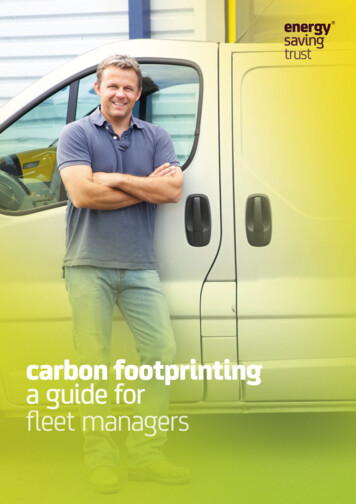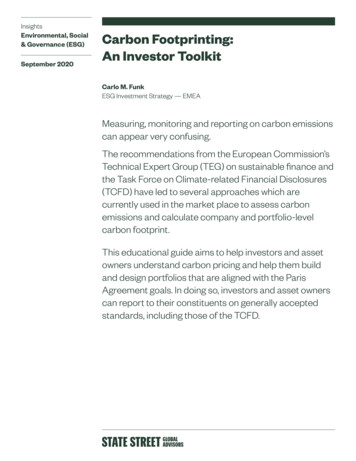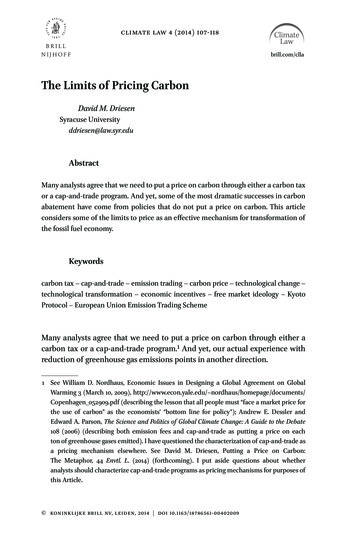
Transcription
carbon footprintinga guide forfleet managers
Carbon footprinting:a guide for fleet managersIntroductionFor some organisations, carbon footprinting isperceived to be about reducing emissions purely forenvironmental reasons. But it is primarily aboutsaving money and complying with reporting andduty of care requirements. This guide explains whyunderstanding your fleet’s carbon emissions isimportant and how robust data management canhelp you to run a greener fleet.There are two key factors underlying therelationship between carbon and cost:This guide is primarily concerned with the first of these factorsand will explain: Carbon emissions in grams perkilometre (g/km) is essentially anotherway of expressing miles per gallon(mpg). The higher a vehicle’s carbondioxide emissions, the higher the fuelconsumption, and vice versa. Benefit in Kind percentage rates, whichcontrol costs including Class 1ANational Insurance contributions andemployee Company Car Tax, aredetermined by the vehicle’s officialcarbon dioxide emission levels. why carbon footprinting is important02 what data is required to calculate orestimate your fleet footprint what to do with the results of thatanalysis to make your fleet moreefficient.
Carbon footprinting:a guide for fleet managersThe rise of CO2To begin, it is worth providing some backgroundon the importance of CO2 emissions forvehicle fleets. Governments, both UK andEuropean, have introduced incentives andpenalties to reduce vehicle CO2 emissions.Vehicle Excise Duty based on tested emissions was introducedfor cars registered on or after 1 March 2001. From April 2002,CO2 emissions became a key element when calculating thecash equivalent value of a company car, on which tax is paid.Over the years the tax bands have been tightened as moreefficient cars have emerged. Carbon dioxide emissions havebecome an increasingly important factor in terms of companycar taxation since the start of this century.03
Carbon footprinting:a guide for fleet managersWhy footprinting is importantCarbon footprints are a key tool for efficientfleet management, yet most organisationsdon’t calculate an accurate footprint for theirbusiness transport.Organisations that do complete a carbon footprintoften do so for reporting purposes, and notnecessarily because of the benefits it can deliver.In our experience, accurate measurement of a fleet’scarbon footprint is an important first step whentackling vehicle efficiencies and cutting costs. Theoutput in terms of the tonnes of CO2 emitted in ayear and compliance with reporting requirementsare both important. However, it is the process yougo through, collating and analysing data, which iscrucial to efficient fleet management.The reason why carbon footprints are such a usefulfleet management tool can be divided into three keyareas: compliance, cost and carbon.Compliance and duty of careReporting requirements should not be the mainreason an organisation measures its fleet’s carbonfootprint. For some businesses there are legislativerequirements to address. Since April 2013, allbusinesses listed on the main market of the LondonStock Exchange have had to provide full disclosureof their greenhouse gas emission levels. A reviewwill follow in 2015 to decide whether all largecompanies should be included from 2016. Even ifyou do not legally have to report your businessemissions, doing so future-proofs your organisationagainst any changes to legislation.The link between carbon footprinting and duty ofcare is crucial but regularly overlooked by fleets. Ifyou have cash opt out and grey fleet drivers, some ofthe information you need to calculate a footprint isthe same data required to demonstrate you aremeeting duty of care requirements. If you don’t knowwhat vehicles your employees are using and wherethey are driving, then in the event of an accident youwill be unable to show that you have ensured thesafety of employees at work.As part of managing the grey fleet properly youshould find out the fuel consumption and carbonemissions of these vehicles. This will enable youto estimate the footprint for this part of your fleet.Your ability to calculate the footprint is a proxyof how much control you have over youremployee-owned vehicles.04
Carbon footprinting:a guide for fleet managersCostCarbon footprinting can help with internal reportingof your sustainability projects by using the cost ofemitting a tonne of CO2 as a metric. The graph belowshows how, despite a slight fall in 2013, rising fuelprices have increased the cost of emitting a tonne ofCO2 by more than 80 per cent since January 2002.While this is not a common way of measuring thecost of running a fleet, it highlights the importanceof managing carbon emissions to reduce costs.CarbonMeasuring your carbon footprint and taking actionto reduce it has a positive environmental benefit.This may help you differentiate your business fromothers in your sector. The customer will see yourorganisation’s commitment to the environmentand you should be able to increase your profitmargins by reducing fuel consumption. In somesectors certain consumers are willing to pay morefor the greener option.It is also crucial to measure fuel consumption andcarbon emissions for individual vehicles and drivers.Poorly performing drivers can be identified andselected for additional training, and inefficientvehicles can be flagged for maintenance orreplacement. Measuring an accurate carbon footprintfor each vehicle and driver can also help you identifyinflated or false mileage claims. 700PetrolDieselCost per tonne CO2 emitted 600 500 400 300 200 100 3
Carbon footprinting:a guide for fleet managersWhat comprises anaccurate footprint?Energy Saving Trust has five methodologies for calculatingor estimating a carbon footprint, with the first beingmost accurate and the fifth least accurate. The choiceof methodology depends on the data available.1A precise calculation can only be made by using the actual quantity of fuelconsumed and multiplying the volume of fuel used by the appropriate carbonintensity (i.e. the kilogrammes of CO2 emitted per litre of fuel combusted).By this method a carbon footprint is relatively easy to calculate and accurate.The alternative four methods rely on assumptionsabout vehicle performance and emissions.2Method two uses the distancetravelled and the car’s official CO2emissions. An adjustment needs tobe made to estimate thedifference between official andreal-world emissions. The carbonfootprint figure produced is lessaccurate because the differencebetween official and real-worldemissions will vary for differentvehicles and different drivers.34Methods three, four and five areincreasingly controlled byassumptions, including enginesize and fuel type, rather than bydata specific to the individualvehicles. Therefore outputsshould be considered asestimations not calculations.5The methodology you are able to use to calculate the carbon footprint is a goodindication of how well you are monitoring your fleet data. If you can use the firstmethod to calculate an accurate footprint, you can be confident that you arecollating accurate data on your fleet. Conversely, if you can only use methodsfour or five to generate an approximation of your carbon footprint, this indicatesthat you do not have good control over your fleet data. The process of calculatinga carbon footprint is as, if not more, important than the numerical output itself.06
Carbon footprinting:a guide for fleet managersThe key question is what datashould a well-run fleet be recording?Van fleetsOrganisations should measure the volume of fuel used, and the mileage covered by eachvehicle, so that an accurate footprint can be easily produced using method one.1Company cars, pool cars and daily rental cars12The carbon footprint for company cars, pool cars and daily rental cars (which should beunder direct control of the organisation) should be calculated either using method one, iffuel cards are in use, or method two, where business mileage and car specific CO2emissions data are available.Cash allowance schemes These should be managed as closely as company cars, as these vehicles often cover highbusiness mileages. The vast majority of these cars should have been registered since2001, and therefore a manufacturer’s official CO2 emissions figure will be available. Youshould be able to use method two to estimate the carbon footprint.2Grey fleet cars23You should be able to use method two as most vehicles will be fewer than 12 years old,though method three is acceptable for some older vehicles.If it is not possible to use methods one and two for the majority of your fleet, then youshould review your transport policies and data collection procedures, from both a costcontrol and a duty of care perspective.Establishing how much fuel your fleet consumes will not provide any indication ofindividual vehicle efficiency. Similarly, accurate mileage records do not indicate how wellan individual driver or vehicle is performing. Determining your fleet’s carbon footprintwill highlight areas where cost and carbon savings are available. It will also help you toforecast the return on investment that might result from measures such as eco-drivingtraining or telematics.07
Carbon footprinting:a guide for fleet managersData collectionEssentially only two pieces of data are requiredfor calculating a fleet’s carbon footprint: fuelconsumption and business mileage. While fuelconsumption data is best taken from fuel cardreports, mileage records can come from eithertelematics systems or mileage capture software.Fuel cardsTelematicsMileage captureWithout fuel cards, accountingfor your fleet’s petrol or dieselconsumption is time consumingand requires careful management.It is often difficult to have thecontrol needed to influencevehicle and driver efficiency andto manage costs. Channellingpurchases through a fuel cardmaximises buying power whilstproviding data to act upon. Even ifyou do use fuel cards, data qualitycan be an issue, so you need towork closely with your cardprovider to ensure reports areaccurate and useful. Finally,reports are no use if they are filedaway. It is important to use thedata they contain to manage yourfleet more efficiently. For moreinformation, download our freefuel card guide (pdf).Telematics systems ensuremanagers know where vehiclesare being driven and how they arebeing used. They can also be usedto log whether mileage is businessor private to improve expensesclaims. While such systems aremost commonly used in vanfleets, they are increasingly beinginstalled in company cars as well.For more information, downloadour free guide to telematics (pdf).An alternative way of accuratelyrecording business mileage isvia mileage capture software.Systems typically involve driverscompleting weekly or monthlyrecords of their mileage byentering the start and destinationpostcode of each journey.Employees also select whethereach journey was personal or forbusiness, which allows a ‘fuel atcost’ approach to be used forreclaiming the cost of privatejourneys. When combined withaccurate fuel consumption data,this will allow you to calculatethe carbon footprint and mpg foreach vehicle and driver. For moreinformation, watch our webinarmanaging mileage: cutting costand carbon.08
Carbon footprinting:a guide for fleet managersCarbon reduction initiativesOnce you have recorded and used youraccurate fuel and mileage data to determineyour fleet’s carbon footprint, the next step isto use this information to implementinitiatives to reduce costs and cut carbonemissions.In summary, a best practice approach to reducing your fleet’scarbon footprint involves: Accurate data capture and measurement. Fuel management and fuel consumption for individualdrivers and vehicles. Training, technology and engagement to promoteefficient driving, which can only be properly monitoredthrough fuel management. Mileage reduction – only possible when journey datais available. Grey fleet management to control risk and minimise mileage. Implementing fleet policies which encourage efficientvehicle choice and driver behaviour.A carbon footprint won’t put these initiatives into place byitself but it is the best starting point to identify where you cansave money, reduce carbon emissions and improve compliance.09
Carbon footprinting:a guide for fleet managersNext stepsEnergy Saving Trust has a range of free andsubsidised services funded by the Departmentfor Transport which can help you measure andreduce your fleet’s carbon emissions.For in-depth consultancy on the fleet challenges your organisation isfacing, and how to overcome them, we offer a Green Fleet Consultancyprogramme. In addition to calculating a fleet carbon footprint, ourconsultants can advise you on company car policy, fuel managementsystems and processes, grey fleet management, data management andmileage reduction strategies.We also offer a free online Fleet Health Check which provides astraightforward fleet carbon footprint and gives recommendationsabout where and how you could cut costs and emissions.10
Energy Saving Trust21 Dartmouth StreetLondon, SW1H 9BPenergysavingtrust.org.ukTE825 Energy Saving TrustFebruary 2014
employee Company Car Tax, are determined by the vehicle's official carbon dioxide emission levels. For some organisations, carbon footprinting is perceived to be about reducing emissions purely for environmental reasons. But it is primarily about saving money and complying with reporting and duty of care requirements. This guide explains why










